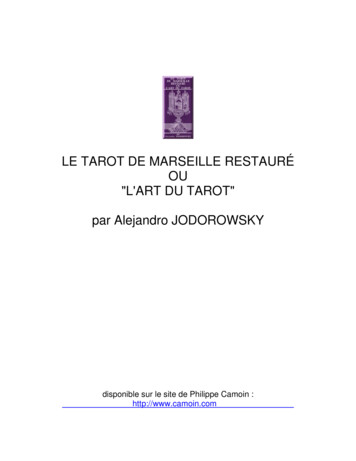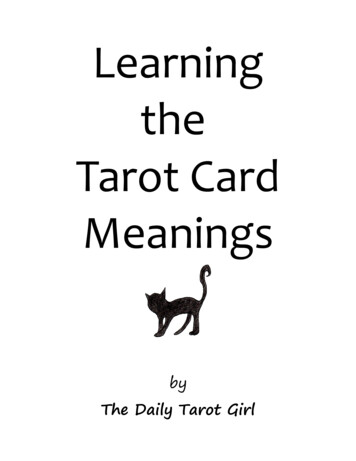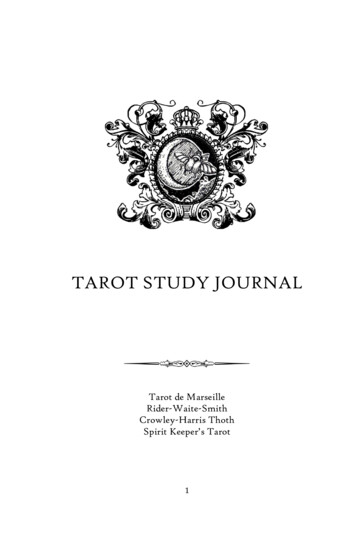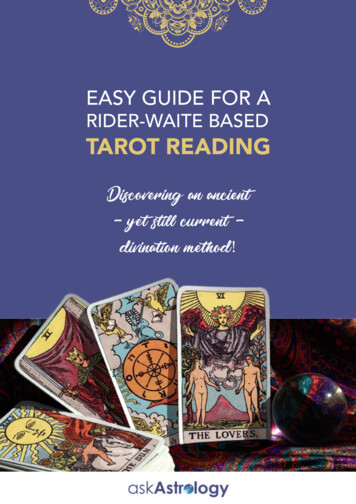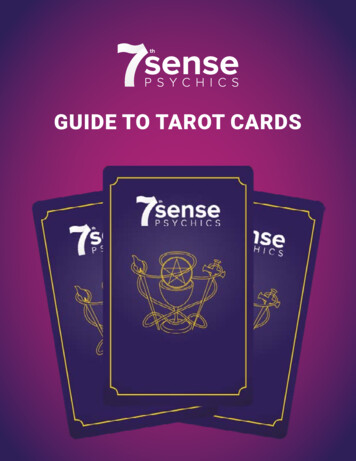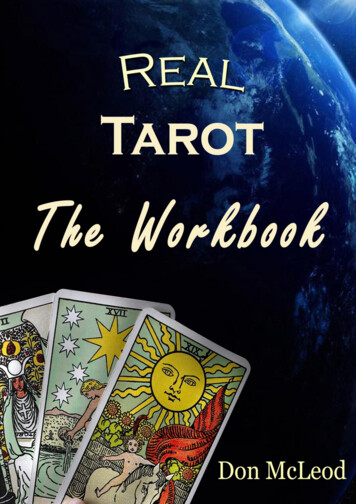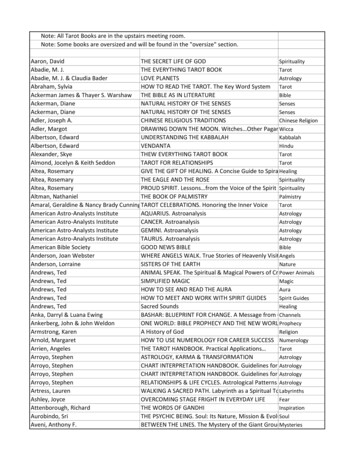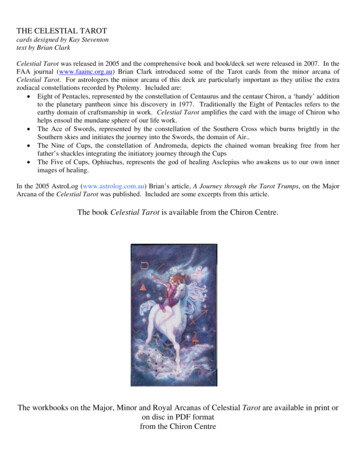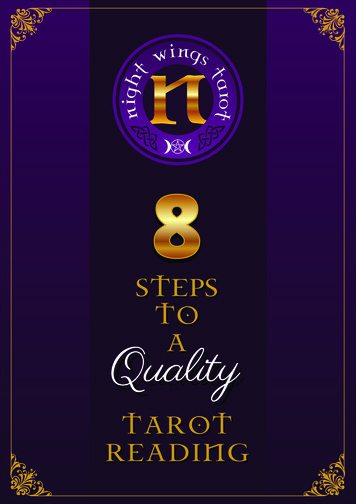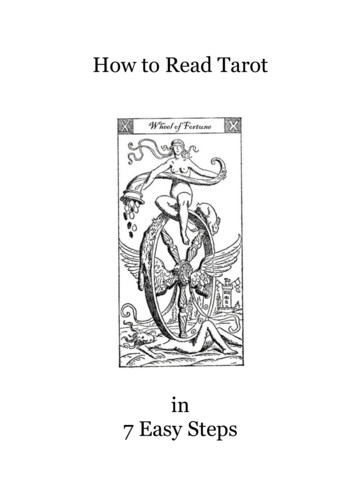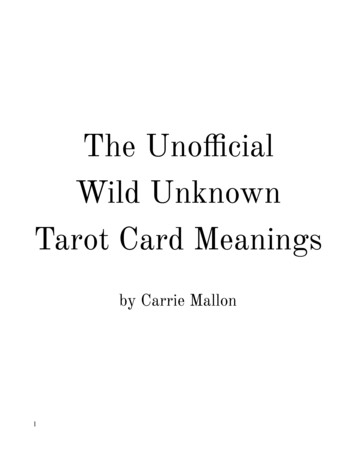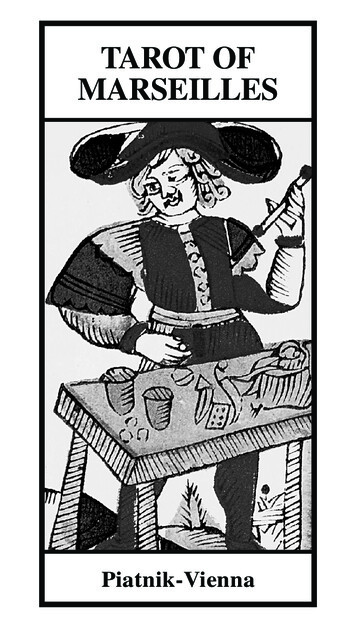
Transcription
TAROT OFMARSEILLESPiatnik-Vienna
TAROT OFMARSEILLESGEORG GOTTLOBPiatnik-Wien
TAROT TRADITION ANDPIATNIK’S TAROT CARDSTHE 22 MAJOR ARCANA OF TAROTTarot consists of pictographic cards, which gaverise to the game of Taroc as it is known in Ourdays.Tarot cards in Europe emerged apparently asearly as in the course of the 14th century partlyin Italy and partly in France. There are theories,however, according to which Tarot in factoriginated in ancient Egypt, from where it tookits course to conquer the world. In many of theEastern countries, from Egypt through India andto China, one actually may find a number ofsuch figurative images with a likeness to theTarot figures: even the Gypsies have such cards,which may explain how these were spread inAsia and Europe.It is just as difficult to prove scientifically thegenesis of the Tarot cards as to ascertain theorigin of the name of tarot. Some scientists thinkthat this name is of French origin, but GustavMeyrinck, in his book ‘The Golem’ is of theopinion ‘[.] that aroc or Tarot has the samemeaning as the Hebrew word ‘Torah’ (the Law),or the name may be connected with the ancient3
Egyptian word ‘Taruth’ (the One who isconsulted), or it may come from the word‘Tarisk’ of the ancient Zend language, whichmeans “I demand the answer.“The Tarot cards are used for “play as well as —and this is more often the case — for “fortunetelling’. A packet consists of 78 cards: 22 of themajor Arcana ( the great mysteries) which arethe same as the trumps in the game of Taroc, andof the 56 minor Arcana (the lesser mysteries).The minor Arcana are similar to the cards of ourmodern games, and are divided into four sults:Swords, Wands, Cups and Coins (equi- valent toSpade, Club, Heart and Diamond) and there arefourteen cards of each suit. The minor Arcana inTarot, however, play a smaller role, and it is saidthat these came very much later into being thanthe major Arcana.THE MYSTICAL SIGNIFICANCEOF TAROTThe 22 major Arcana have always been thesubject of mystical considerations. PrincipallyMagicians and Hermetics used these cards.Many of them saw in Tarot a microcosmicuniversal formula apt to explain the happeningsin the Universe and could even interpret the4
meaning of existence. The understanding of thisformula certainly needed a considerable degreeof dedication and time consuming meditation inrespect of each card.Some mystics believe that Tarot is a sort ofprimeval scripture or language similar to theecstatic utterances mentioned in the Bible.These theories approach the psychologicalcharacter of Tarot. The course of researches ofthe French cabalist Eliphas Levi and of the“enlightened” wigmaker Etteila d’Odoucetfollowed a similar direction in the middle of the19th century. Both established connectionsbetween Tarot and the Hebrew alphabet. Eachof the 22 Hebrew letters corresponds with the 22major Arcana. This assertion is not withoutfoundation as it complies with other theories asto the origin of Tarot. This connection with theHebrew alphabet may point to a way of linkingTarot cards with an art of cabalistic letter andnumber mystic. Perhaps the Jewish secretdoctrine of cabala may give us advice as to themeaning of the single cards.The main work of the cabala, the Sohar( Brilliance) treats, among others, thedifferent properties of the Hebrew letters fromwhich the significance of the Tarot cards may5
derived. According to a more daringassumption Tarot might be a part of the cabalaitself. Very little is known of the use of Tarotcards in magicspeculative rituals.Tarot may also be connected with astrology: inthe 19th century the Frenchman “Christian”related Tarot cards to the signs of the Zodiacand also to the Planets of the Solar System.Some representatives of modern esotericteachings, like Franz Bardon and ElisabethHaich, see in the major Arcana the differentstages towards the mystical initiation. Thecards might be milestones on the road to be anadept, where each card corresponds exactlywith a state of consciousness. Thus Tarot maybea road to man’s perfection.THE PSYCHOLOGICALIMPORTANCE OF TAROTThe word ‘perfection’ used in the previouschapter, must not be given any mysticalcharacter. According to depth-psychologyperfection means finding the way to one’s ownself, as man in fact is still quite unknown tohimself.Sigmund Freud proved that to a great extentour psyche is unknown to us: our6
consciousness is only a small isle in theunconscious which is governed by this latter.The Swiss psychologist. Dr. C. G. Jung,established that the ‘unconscious’ is governedby a nucleus „which is the same in all humanbeings, the ‘collective unconscious.” Thisconsists of prototypes, termed archetypes, whichstrongly influence man’s behaviour and phantasy.Perfection can be attained by opening up theunconscious to the conscious, first of all thecollective unconscious, of which normal humanbeings have no awareness, by making manperceive it and to experience it. C. Jung calls thisphenomenon the individuation process.The 22 major Arcana of the Tarot represent instages the entire individuation process.Beginning with card one (the Magician) to cardtwenty-one (the World) the single cardssymbolize on the whole the disposition of manon the way to the state of individuation. Some ofthe cards are straight copies of certainarchetypes (further details will be given whenthe different cards are described). Thiswonderful fact has an easy explanation: theinventor of the Tarot, be he an Egyptian or aEuropean, most probably designed these cards in thecourse of his individuation process, in order to fix7
pictorially for himself the way leading to hisown self. The archetypic symbolism of thecards explains also their popularity with manypeople.As to the position of card 0, the Fool, people donot quite agree. It should, in the mind of some,occupy simultaneously the first and the verylast place (one might thus form a circle withthe Tarot cards), as one starts the individuationprocess as a fool, and after perfection standsagain as a fool in front of a higher stage offurther development.Tarot cards, however, are not only anillustration of the individuation process, theycan also be used as a help to find one’s ownself. By meditating over the single cards onecan make the unknown implications consciousand so proceed on the way to accomplishment.Apart from all these considerations, Tarotcards give rest and relaxation from a hecticevery-day life and take one for a short time intoa world of colour and fantasy.DIVINATION BY MEANS OFTAROT CARDSTarot and fate are often tied together. TheAnglo-Indian theosophist, H. P. Blavatsky8
in her “Geheimlehre“ (Theorie of Mystery)gives a hint that the Tarotsymbol was alsoknown in ancient Egypt as a part of the ‘Wheelof Fortune’ (which is shown on card X) andused for divination purposes. It is not so easy toverify this allegation. One thing, however, iscertain: Gypsies used and keep on using Tarotcards for fortune telling. This Gypsy customsgave rise in 19th century Paris to the practice oflooking into the future by means of these �� of Paris also earned theirmoney mainly by using Tarot cards.If someone in our days buys Tarot cards, it isalmost always for divination purposes. Manyesoterics, however, are of the opinion thatfortune-telling is alien to the purpose of Tarot andbasically is a debasement of its comprehension.Everybody’s attitude to fortune-telling is hisconcern, but it has to be stressed that when layingout cards and interpreting them no strict rules orrituals are to be observed. On the contrary, justlooking at the cards suggests spontaneous andintuitive ideas and insight.The ‘Implications of Fortune-Telling’ aregiven for each card and these comply with thedirections laid down by Etteila.9
NOTE CONCERNING THE FOLLOWING DISCUSSION OF THE MAJORARCANAOwing to the lack of space in this booklet, it isimpossible to give even an approximatelycomplete description of the Tarot cards.Further, we must point out that these cards withtheir mainly hidden implications cannot berationally interpreted, but have to be graspedby intuition. Therefore, the followingdiscussion of the cards is restricted to the mostimportant aspects. Mainly impressions will beconveyed.10
SHORT DESCRIPTION OF THEMEANING OF THE SINGLECARDSI. THE JUGGLER OR MAGICIAN(LE BATELEUR)This card shows the picture of a Magician. It isthe symbol of men at the start of his spiritualdevelopment. He is beginning to grasp, tonotice that besides the banalities of everydaylife there are other more important things. Thefour symbols, which are also the suits of theminor Arcana are: Cup, Sword, Wand andCoins. They are also the symbols of activity.The first Tarot card symbolizes also a potentialstrength which, for the time being is not free,and through the other Arcana will be unfolded.The Magician with his posture reflects anAleph, the first letter of the Hebrew alphabet.DIVINATORY MEANING: Who dares, wins!II THE FEMALE POPE OR HIGHPRIESTESS (LA PAPESSE)This picture is perhaps the equivalent of anarchetype. It depicts the ‘Guard of the11
Threshold’, in the mystical sense the Being whohas the power to help us reaching higher regions;she possesses the ‘Book of the Worthies’. In thepsychological sense this woman symbolizes thebridge between the Unconscious and theConscious. Man has forged ahead as far as theborders of his Conscious and is now going to passto the Unconscious. In literature this figure isperhaps the equivalent of Kafka’s Doorkeeperbefore the Law.DIVINATORY MEANING: Problems; at timesit is better to remain on the surface and not tosearch the unknown.III THE EMPRESS (L’IMPERATRICE)Psychologically this figure corresponds with the‘Archetype of the great Mother‘ and thisArchetype on the road to individuation willbecome conscious. The Great Mother is an idealwhich most religions recognize. In ChristianityMary is the ideal of motherhood. According to theNew Testament (Revelations of St. John, 12.1.)another heavenly woman is presented to us: “Andthere appeared a great portent in heaven, a womanrobed with the sun, beneath her feet the moon andon her head a crown of twelfe stars [.].“ She isalso the symbol of fertility.12
The road to the Unknown has begun. Just as thechild at its birth first looks for its mother, so theman, on his road to himself, as soon as he haspassed the curtain, looks for the Archetype, theGreat Mother.DIVINATORY MEANING: Intuition, action.IV. THE EMPEROR OR SOVEREIGN(L’EMPEREUR)The meaning is harmony and considerationtowards other people. One learns to curb andcontrol one’s emotions.The Emperor knows how to tame the everchanging forces of the Moon. The eagle as theking of the air means eminence. Strength, whichin the form of the Magician (I.) was onlypotentially present, may now reveal itself freely.DIVINATORY MEANING:mental power, understanding.Will,might,V. THE POPE OR THE HIGH PRIEST(LE PAPE)As the spiritually developing man has gainedwordly dignity by means of the precedingcards, so here he learns to acquire the rightattitude towards religion and to live a spirituallife.13
Man as High Priest now knows the way to theUnconscious, he himself holds in his hands‘the Key to the Mysteries’.However, at his feet the figures, one red, theother one green, refer to a split of the mind.There are two roads to knowledge.DIVINATORYMEANING:Religiousinspiration, responsibility, some doubts.VI. THE LOVER - THE CROSS-ROAD(LAMOUREUX)This picture shows the lover. The split in themind hinted at in Card V is now theoverriding problem. On the way to the Self,one is put to a hard task. Mystics migth sayone must now make the final choice betweenblack magic (represented by the dissolute redwoman) and white magic (yellow, gentlewoman). There is a choice of twopossibilities. But the lover holds an Amulet, aguiding star which securely will lead him tothe correct choice.DIVINATORY MEANING: Love, one has tomake one’s own choice.VII THE CHARIOT (LE CHARIOT)This card shows ‘The Searcher’ in a charioton his way to perfection. The decision14
demanded of him, has been made and the rightway has been chosen (Card VI). The Magicianhas conquered all temptations. Antimony inalchemy means activity, quick development.DIVINATORYMEANING:leadership, providence.Triumph,VIII. JUSTICE (LA JUSTICE)The notion of good and evil must not only be feltbut have also to be understood. The eighth Tarotcard brings the comprehension of the true values.The scales provide the absolute equilibrium ofthe good and bad forces in man. Good and evilare evenly distributed in the world. Yang andYin make even.One learns to differentiate.DIVINATORY MEANING: Justice, reward orpunishment.IX. THE HERMIT OR THE OLD SAGE(L’HERMITE)This card shows the decidedly archetypalfigure of the ‘Old Sage‘ or the Hermit.C. G. Jung writes: “In experiencing thisarchetype, modern man is led to the most ancientart of thinking as an autonomous activity, theobject of which is man ‘further’ . this15
archetype always appears in a situation whereinsight, good advice, etc. would be of firstimportance.”Actually, the Old Sage is a figure with whom, onthe way to individuation, one will be confrontedin order to be able to proceed. He is the carrier ofLight and has the power to ban the serpent oftemptation. For the Initiated this form is perhapsthe equivalent of the ‘eternal great Masters’, likeSt. John the Baptist or Christian Rosenkreutz.DIVINATORY MEANING: Sagacity, goodadvice, foresight.X. THE WHEEL OF FORTUNE(LAROUE DE FORTUNE)This indeed is one of the most peculiar of theTarot cards. Through the Wheel of Fortuneman realizes the unstableness of earthly fate.Once the monster Typhon (identical with Seth,the murderer of Osiris) is at the top, evildominates. Shortly afterwards Typhon will behurled into the Ocean, and Anubis (lateridentified with Hermes Hermanubis) willcome to power. All the contrasts, good andevil, life and death, keep replacing each other.The Sage, on the other hand, is not affected bythese. He, like the Sphinx, is above all.16
Krishna’s saying in the Bhagavadgita is themost apt in respect of this card: “A wise mannever raises a complaint against anyone metingout life and death.”DIVINATORYMEANING:Fate,changeableness of things, transformation.XI. STRENGTH (LA FORCE)Trough spiritual purification and love immensestrength can be freed. Belief moves mountains.Who has courage and perseverance mayaccomplish anything, and remove all obstacles.Even the most malevolent spirits (the wildlion) can be tamed by a good and wise man.Strength may also mean the faculty of healingor the power of mind. This card embodiesflowing energy which drives men onward.DIVINATORY MEANING: Strength, healing,courage knowledge of one’s self, action.,XII. THE HANGED MAN (LE PENDU)This card shows the Magician of Card Isuspended from a rod upside-down. He haszone through the major part of theindividuation process. His posture meansretrospection and also a change in theperception of time and space.17
Sofar man has considered all things from theangle of their usefulness. Now he begins to lookat everything also from another perspective. Inaddition, all things now also have symbolicimportance.A hanged man may be a sinner undergoing hispunishment, but may also be a saint, a Martyr.The notions ‘saint’ and ’sinner’ are related justbecause they are antithetical.DIVINATORY MEANING: Reversal of values,ordeal, tribulations.XIII. DEATHIn the course of every initiation or individuationprocess, one has to die a symbolic death. This is inorder to experience the just acquired‘enlightenment’ pure, like a newborn baby. Whenadmitted into a secret order, like the Templars orRosenkreutzler, the candidates often had tosubmit themselves to a symbolic death.Christianity too knows of a symbolic death.Baptism, as practised by St. John means the deathof man the sinner (submerging in the water), andthe resurrection as a new innocent being.Death means the drawing of the final line,extinguishing, forgetting.18
DIVINATORY MEANING: Solving theproblems, the unavoid-ableness of a change,initiation to new truths.XIV. TEMPERANCE — EQUALIZATION(TEMPERANCE)This card shows a figure with a likeness to theGreat Mother. She is the queen of the skies, theeternal moderation, adjustment and theexpression of modesty. The ancient Chinesework “Book of Transformation” (I Ging) says:“In the womb of the Earth there is amountain: The true picture of modesty. Sothe most Noble lessens what is not neededand multiplies what is scarce. He weighs thethings, and makes them equal.”Contrasts will be made even. This is theprerequisite for experiencing the mostimportant and strangest Archetype: theSoul or Anima.DIVINATORY MEANING: Moderation.advisability of thriftyness, choice of the middleof the road.XV. THE DEVIL (LE DIABLE)Here there is to be seen a two-leggedhermaphroditic being which depicts the Devil.19
The Devil corresponds here to an archetypicalphantom-figure (a figure of the negative half ofthe ego) which hinders man in getting intodirect contact with his soul. Man himself issymbolized by the male captive of the Devil,his soul, on the other hand, by the captivewoman in chains; a female figure representsman’s soul in the teachings of Jung. Man andSoul will be by satanic spell kept apart.DIVINATORY MEANING:temptation, great mystery.Subjection,XVI. THE HOUSE OF GOD TOWER STRUCK BY LIGHTNING(LA MAISON DIEU)By conscious perception of the devil’s picture(Card XV.) one can succeed in freeing man andsoul (depicted by the two figures) from thegaol of the devil (the tower in the picture). Thisis tied with a tremendous shock of the entirePsyche.“Continuous Thunder: illustration of thecollapse. This is how the Illustriousshaking and stricken with fear improveshis life and scrutinizes himself.”(Quoted from I Ging).20
The devil who has been recognized as anegative appearance of the Ego, exists nolonger. The house of the devil, the Tower, willbecome, by means of the ‘purifying’ lightning,the House of God.DIVINATORYMEANING:Collapse,significant change, mental derangement.XVI. THE STARS (LESTOILE)The Soul, after having been freed, can nowdevelop and open up. Card XVII of the Tarotshows the Soul in the form of an uncoveredfemale figure under the starlit skies in aparadisiac landscape. The Phoenix means thefreedom of the Anima (soul). One should notforget that according to modern psychology,Soul is to be looked upon as an autonomous partof man governed by its own will and laws.Emptying the two vessels means the completedetachment from every bond.DIVINATORY MEANING: Hope, liberation,salvation.XVIII. THE MOON (LA LUNE)Soul, perhaps, is the most important but not thelast Archetype which will be made conscious.Man still has “to get rid of the animal-likeimpulses of the Unconscious” according to thewritings of Aniela Jaffe,21
“whereby man must be bitten by a beastwithout trying to escape”. The animals here areprobably the two dogs and the crab. Passingthrough the Gate and crossing the water are thelast probes of steadfastness. Actually theposition of this card can hardly be understoodrationally. Intuitively, however, one may graspthe position of the card of the Moon, thedominating colour of which is yellow.“It is advantageous to cross the great water” asit is said in Ging, and perhaps we mayrecognize the connection.DIVINATORY MEANING: Peril, a trap,warning, trial.XIX. THE SUN (LE SOLEIL)When at last all obstacles are conquered canman (Spirit) and Soul (shown here in humanform as man and woman) unite and attain theirend in order to build the new true Self(represented on the next card by a child). Thisis the peak of individuation. and the higheststage of conjunction between Spirit and Soul.This greatest inner experience can only belikened to the most impressive external eventman ever witnessed; the sight of the Sun.DIVINATORY MEANING: Happiness,salvation, marriage.22
XX. THE LAST JUDGEMENT(LE JUGEMENT)The Self is now depicted here as a child of theSpirit and the Soul. The birth of the Ego isgoing to be heralded by an Angel. For man,who attained Individuation, the highest gradeof development, is now facing the lastjudgement. The Self has been brought aboutby the immaculate union of the Spirit and theAnima, therefore it is sacred. Man who startedin profanity at the culmination of his initiationhas become a saint.DIVINATORY MEANING: Progress,judgement. elevation, child.XXI. THE WORLD (LE MONDE)We see here our initiated as a delicate womansurrounded by a wreath of rays. In the handshe (she) holds two scepters: there possibly aretwo opposite poles with which Fate can begoverned. “The magic wands are her lawswhich irremovably rule and act in the wholeUniverse” writes Elisabeth Haich.The Magician in a female form is surroundedby the four Biblical animals, which alreadyappeared in the vision of Ezekiel, and whichare also to be found in St. John’s Vision ofGod (The Revelation of St. John). These23
animals perhaps mean that the initiated is unitedwith God and in this way reigns with Him.DIVINATORY MEANING: Benefit, spiritualperception, perfection.THE FOOL (LE MAT)As already hinted, this card can be consideredas the first and last card of the Tarot. Previousto his psychic development man is a fool,because he has no notion of the possibilitiesopen to him, of the mystical potentialities hemay still develop. As an accomplished adept,in the eyes of other people he is again a Fool,because he has renounced fame and riches.Is the Fool perhaps hinting at the hiddenpossibility to consider the world as a gamble,as a crazy hurly-burly? Is the Fool not happierand, in fact, not wiser than all the other people?The Fool at the beginning and at the end of theTarot is possibly also a symbolic warning orthe advice that one should not even try to graspthe Tarot cards rationally.DIVINATORY MEANING:deception, the greatest freedom.24Foolishness,
THE 56 MINOR ARCANA OF TAROTThe opinion in respect of the 56 “lessermysteries” of the Tarot 1s that they were only aconsiderable time later added to the 22 majorarcana, so that these may be complemented to agame of 78 cards. The two figures 56 and 78also have a fair number of mystic andcabalistic explanations. In the view, forinstance, of the French Tarot expert GerardEncausse, known under the pseudonym“Papus“ , in the computation1 2 3 4 5 6 7 8 9 10 11 12 78there is an indication as to the completeness ofthe 78 cards of the Tarot. Most of the fortunetellers are of the opinion that, in general, onemay get the answer by consulting the majorarcana only, but in order to find out more exactdetails it is neccessary to make use of theminor arcana. Scientifically well-founded isonly the assumption that all modern cardgameshave developed from the minor arcana. Thefour Tarot suits, Swords, Wands, Cups andCoins are called Italian suits.The cards of the minor arcana, as a matter offact, can be used for the purpose of playing25
In the following we are going to explain amethod of laying out the cards, which needsthe use of both the major arcana and minorarcana; after that the four suits with all of theircards will be described and the meaning of thecards will be given for the purpose offortune-telling.METHOD OF THE MAGICQUADRATEBefore consulting the cards those of the majorarcana and of the minor arcana should beshuffled separately and then put in two talonsupon the table, face downwards. Duringshuffling the fortuneteller concentrates, doinghis utmost, upon the question or problem put tohim so that he may obtain the intuition neededfor the interpretation.Now altogether 9 cards will be taken from thetwo piles in the following order: the first oneshould come from the major arcana talon, thesecond, third and fourth should be taken from theminor arcana cards, the fifth again is one of themajor arcana lot, the next sixth, seventh andeighth are from the minor arcana heap and lastlythe ninth is again taken from the major arcanapile. The nine cards shall now be laid down in the26
following quadrate constellation (the cardsare now face upwards):816357492The major arcana cards are put in one column,one under the other (1, 5, 9), these are calledthe numbers of “principal influence’. Left andright of each principal influence card are laidthe appropriate numbers of the “secondaryinfluence“ all coming from the minorarcana. The left side numbers of secondaryinfluence reflect the rather negative, whilethose on the right side represent rather thepositive aspects of the principal influence.The figures in the first line (8, 1, 6) stand forthe past, that is for former powers which haveacted upon the problem to be treated. Thesecond row (3, 5, 7) represents the present andthe third one (4, 9, 2) is for the future. Themajor arcana should be interpreted ratherintuitively, the meaning of the minor arcana,to be dealt with in the following pages, incitesthe phantasy less. The above constellationwill be called the “magic quadrate“ becausethe sum of the figures in all lines, all columns27
and all diagonals give again the same magicnumber 15. The following “number-mysticalformula”: shows the direct connection to Tarot.78 7 8 1578 56 22 5 6 2 2 15THE COINS (LES DENIERS)The first series of the minor arcana consists ofthe fourteen cards of the suit “Coins”. Thesecards show large pieces of gold which,excepting some ornamentation, exhibit nonumerical value or inscription. The inferencetherefore is that the coin is the mostappropriate symbol for richness, materialwealth or assets. In its oversize depiction itmay also be considered as an image of the sunand so it is associated with the alchemicelements, fire and the southern region of thesky.Some symbol interpreters do not see any coin inthe golden discs, but the golden salver on whichthe lamb was sacrificed at the passover festivities,accordingly religious interpretations are alsopossible. The coin due to its perfect shape is againa token of accomplishment. The Argentinian28
Alberto Cousté writes about the coin in hisbook on Tarot:“. sign of the action of the will, matter,pillar of the spiritual activity; synthesis,trinity linked with unity.”THE COINS (LES DENIERS):Divinatory Experience,married manCunning, HarmfulintentionsQueen(reine)Freedom, darkhaired womanLife with nofreedom, breakwith a friendKnight(chevalier)Patience, youngmanWar, controversyPage(valet)Healthy ideasEvil thoughtsISecurity protectorLossesIIExceptional profitby a lucky chanceDifficultiesIIIArt, Muse,TalentShortcomings dueto vanityIVBold conceptionPettinessVEverything will besolved by itselfDistress, tearsVIWinnings, gainSpiritual irresolution,insecurity31
VIIProgressImportant things willnot be taken intoconsiderationVIIIModestryrecognition bycommendationImpetuousness andgreedIXPrecaution avertsunpleasantnessLack of precautionXFatherland, House,A home ofone’s ownBad weatherSleepless nightTHE SWORDS (LES EPEES)The sword is generally considered as a sign ofmasculinity, strength, courage, ambition, but itis looked upon as a symbol of enmity and fight.The sword gives to its holder power andauthority. it is worn by knights, therefore itmeans also a noble way of thinking. Thereligious wars were fought with the sword andthe Holy Grail was guarded by its custodianswith the sword. Here too there are elements ofreligious symbolism.The sword in the alchemistic conceptioncorresponds with the element of air and withthe celestial region East.It is made easier to unravel problems by meansof a sword. so was Alexander the Great able tosolve the riddle of the Gordian Knot cutting itwith his sword.30
THE COINS (LES DENIERS):Divinatory AuthorityToo little ant demeanourin societySolitudeKnight(chevalier)Spirit, energy,braveryLack ofsteadfastnessPage(valet)Vigilance,dark-haired manCarelessness,violation of the lawsIStrengthPhysical rIIIAn oldacquaintance,chance meetenigPartingPettinessIVFulfilment of an olddreamMisfortuneVDisappearance ofharmful influencesDestructionVICalming down,reassuranceOversleeping animportantappointmentVIIPhantasyToo irrationalthoughtsVIIIGood tidingsBad news31
IXRomanucism,happiness in loveLove’s pangsXAnenemy becomesa friendMisfortuneTHE CUPS (LES COUPES)When we have treated the Swords as a symbolof masculinity, it suggests itself to consider thecups decidedly as of a feminine character. Thecup, the jug or the goblet are seen asreceptacles, for receiving and holding. Oftenare they associated with feeling and emotion.The emptying of the two jugs on card No. XVIIof the major Arcana means nothing else but thedetachment from all sentimental bonds.The cup as it contains fluids logically ismatched with the element water, and itscelestial region is the north. From the religiousviewpoint the cup is often identified with thesymbolic goblet held by Christ, or with theHoly Grail, the vessel containing Christ’sblood.That the cup symbolizes feelings isascertainable by its later changing to heartin card-games.32
THE CUPS (LES COUPES):Divinatory ier)New propositionsWrongly conceivedplanPage(valet)Intellect and talentMental errorIBeautyBrooding marsintended plansIIMarriage orengagementImpostorIIIFulfillmentUpset plansIVBlond girlEnmityVRespect gainedUnpopularityVIGood prospectsChancesUnbridledphantasyVIIOne gazes into thefuture inone’s dreamsIllusionsVIIIOne rectifiesoneselfDisappointmentIXBenefits, gainsSlanderXSatisfaction withothersComplacency33
THE WANDS (LES BATONS)The last fourteen cards of the Tarot are thewands or sceptres. As to the meaning of a wandevidence is give
assumption Tarot might be a part of the cabala itself. Very little is known of the use of Tarot cards in magicspeculative rituals. Tarot may also be connected with astrology: in the 19th century the Frenchman "Christian" related Tarot cards to the signs of the Zodiac and also to the Planets of the Solar System. Some representatives of .
